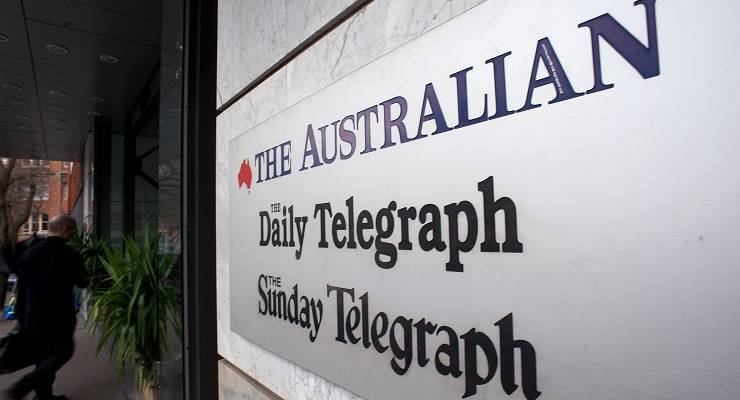
News Corp’s regional and local network shuttered. Its campaigning newspapers increasingly unbought in print, and falling out of the top 10 digital destinations for news. Foxtel in financial (and audience) collapse. Sky with telephone booth audiences.
Time to mix up fairy-tale analogies and ask: who’s afraid of the big, bad wolf when he has no clothes?
Last week’s corporate restructure revealed that News Corp is losing the battle for an internet-centred business model. Worse, it’s already lost the more important fight: the war for attention.
Former News Corp Australia boss Kim Williams shrugged off concerns about the company’s bias in April with a “sure, but it doesn’t really matter”. (His exact words: “It attributes a level of power to old media that I don’t think they have any longer.”)
It surprises us because News Corp has been such a significant media influencer for so long — and the dominant influencer since the mid 1980s. In that time, it’s rolled through three overlapping cycles in response to its perception of what its increasingly grumpy-old-man audience wants, as well as the political and commercial interests of the Murdochs.
It brought a sharpened brio shaped by the best of tabloid journalism first to Sydney in the 1960s and 1970s and then to the rest of Australia in the 1980s. It made Australian journalism better, more relevant. But it also demonstrated how the style could be wielded as a political weapon when it turned it on the Whitlam government in 1975.
In the mid-eighties, as the company morphed from scrappy outsider to belligerent insider with the takeover of the Herald & Weekly Times, it deepened its reporting with an overlay of more sober Canberra-centred policy analysis (then called “economic rationalism”, now known as neoliberalism).
The News Corp papers — and The Australian in particular — became the intellectually dominant force in Australian journalism. More than any other organisation, they determined what was (and was not) news.
Its approach was mixed: all economic rationalism all the time, but committed to the policy, not the party. It supported Hawke and, later in the UK, Blair. It actively resisted the Liberals’ flirtation with racism between 1988 and 1990 and gave Indigenous issues a mainstream voice around the 1992 Mabo decision.
But the injection of Fox News into its DNA — the first dose coming after 9/11 and the second after the 2008 financial crisis — saw that tabloid sensibility and policy overlay metastasise into something much more lethal: the media voice of the right’s ethno-nationalist project.
In Australia, it aligned with the Abbott-led substitution of complex policy with three-word slogans, turning its op-ed writers in The Australian and columnists in its tabloids into something more like pamphleteers.
It intensified a visceral opposition to Rudd and Gillard (and, in the US, to Obama). It brought the tabloid style to the knife fight of the culture wars, particularly to target women and people of colour. Both in Australia and the US, it became a comfortable retirement home for conservative politicians.
It left News Corp, in Australia at least, with the look of journalism, but the feel of a political party, as Malcolm Turnbull wrote in his memoir. In effect, it has pulled off a not-particularly-friendly take-over of the Liberal Party from the right, much as Fox has with the US Republican Party.
This Foxified Australian arm did not emerge overnight. For a long time — and still in parts — News Corp sustained some strong voices practising good, deep journalism. But year by year, those voices have drifted out — retrenched, retired, moved on.
This new News Corp has not gone unnoticed or unchallenged. Its hubris has made it a target, from Hacked Off fighting the company’s methods in the UK through to the Sleeping Giants discouraging its advertisers.
This sacrifice of journalistic values has seen the company increase influence with conservative governments. Right-wing politicians are right to want to keep them on side. That’s why Scott Morrison still enthusiastically offers up interviews in front of the micro-audiences who watch Sky after dark.
But News Corp’s readership is now closer to a party’s political base than curious news-seekers (just read their comments!). Great for subscriptions behind a pay-wall. Not so much for public influence.
The result? Business model meets echo chamber.








Behold the bitter harvest Rupert sowed.
While this is actually great news in so many ways, it still leaves the the unanswered question, “What will I have to wipe my bottom with in the next pandemic?”
Same as this time. Whatever it is, it won’t be a Newscorpse rag, which already has shit all over it.
this an age of disruption , printed press is dead , ahh 20 yrs ago , news and opinion will live online , get over it , news is global , who cares if miss’s gerphilps gratefruit didnt ripen , lose the parochial , a quality independent news model is awaiting , ring judith neilson , perhaps insteand of all the small buzzfeed etc , you need to get together to create a sizable entity , fragments wont last
An article on Murdochism in Australia that doesn’t mention anything about Fairfax-09. Odd.
Every step taken by Rupert and his family was assisted by a mis-step from the only other organisation that might have mattered. Investigations into Labor potentates of Lebanese heritage look spectacular to colleagues from the inside, but it’s inconsequential for those of us on the outside. Apparently they still pay Fitzsimons to write for them, rather than the more logical reverse.
Parrot cage, hall of mirrors and echo-chamber all rolled into one repetitive, self-absorbed noisy hellscape.
see you next tuesday